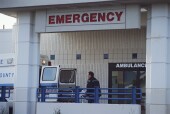
WEDNESDAY, Sept. 29 (HealthDay News) — Black and Hispanic patients who seek care for chest pain in U.S. emergency departments are less likely to be classified as needing immediate care than white patients with similar symptoms, new research reveals.
Depending on an initial assessment known as triage, patients are either targeted for immediate urgent care or deemed able to wait for a longer period of time.
“In this first nationally representative sample of emergency room patients, we found persistent racial-, gender- and insurance coverage-based differences in triage categorization and cardiac testing,” study lead author Dr. Lenny Lopez, from the Mongan Institute for Health Policy at Massachusetts General Hospital, said in a hospital news release.
“Emergency room triage is the critical step that determines the whole cascade of clinical decisions and testing that happens next,” he added. “So if patients are misclassified on arrival, they won’t receive the care they need when they need it.”
Lopez and his colleagues reported their findings in a recent issue of the journal Academic Emergency Medicine.
The American College of Cardiology and American Heart Association have standing guidelines that state that all patients, regardless of demographics, should receive an immediate electrocardiogram (ECG) examination if they present with chest pain.
To see if actual practice deviates from this protocol, Lopez and his team analyzed data collected by a national survey of emergency departments between 1997 and 2006. The survey had gathered information regarding the age, gender, race/ethnicity and insurance status of 22,000 patients who arrived at the emergency department with chest pain, tightness and/or chest burning.
Black and Hispanic patients seeking care for chest pain were much less likely than white patients with similar symptoms to be deemed in need of “emergent” or “urgent” care (those needing care immediately or within an hour, respectively), the findings showed.
Both groups were also less likely than whites to undergo an ECG, which is normally standard for apparent heart attack, or to be monitored for heart function and heart enzyme levels.
Medicaid patients and uninsured patients were also less likely to be handled according to protocol, the investigators found.
“These differences in ED [emergency department] triage may be important drivers of disparities in testing, procedures and eventual outcomes,” Lopez said in the news release. “If you are misclassified at this first step, you’re less likely to get the ECG because your condition is not considered urgent.”
Ultimately, an even more severe heart attack might be prevented with proper treatment initially, he added.
“This is not an area of medicine where there is a lack of clarity about what we are supposed to do, so quality improvement strategies need to focus on 100 percent guideline-driven triage management for every single patient,” Lopez said.
More information
To understand more about chest pain, visit the U.S. National Library of Medicine.

